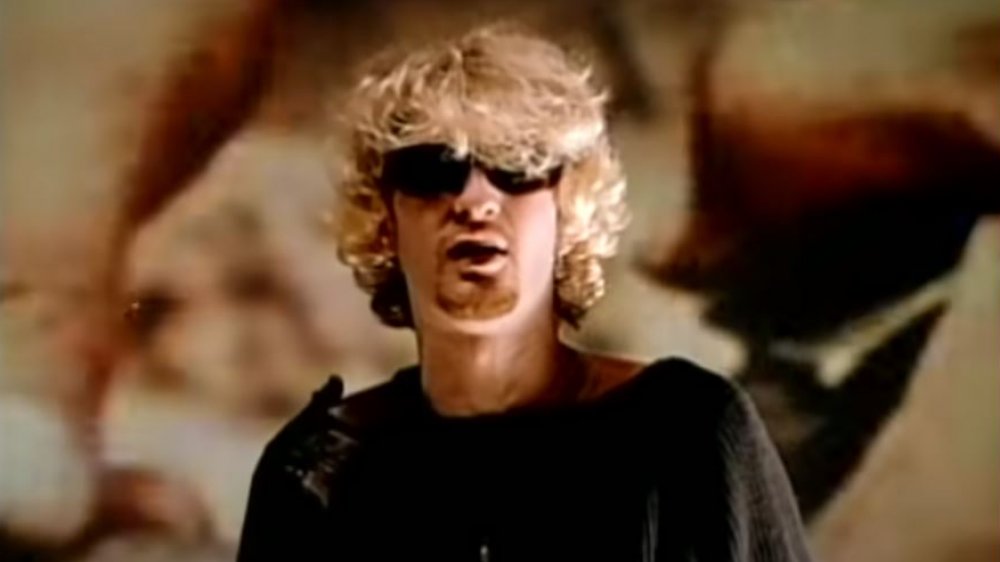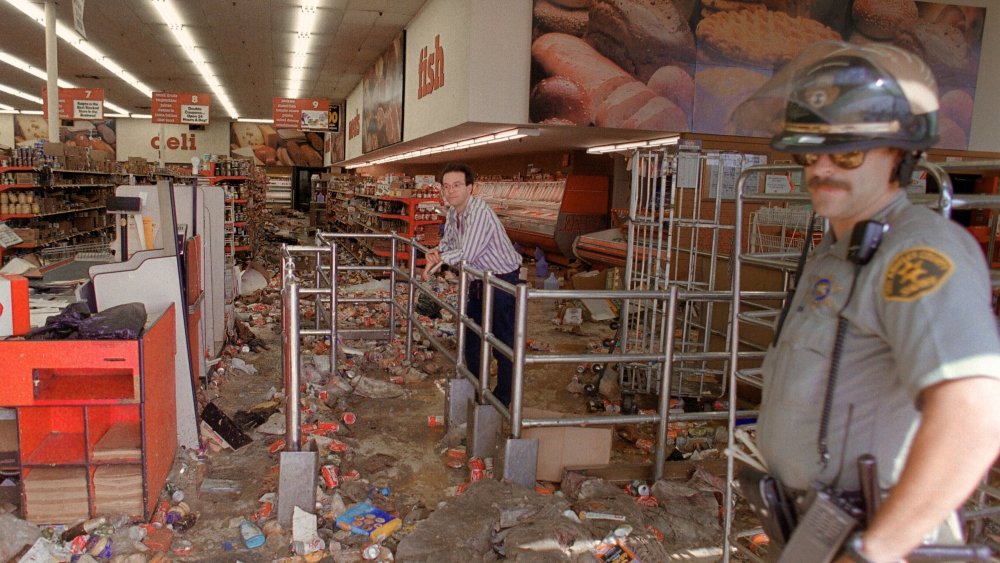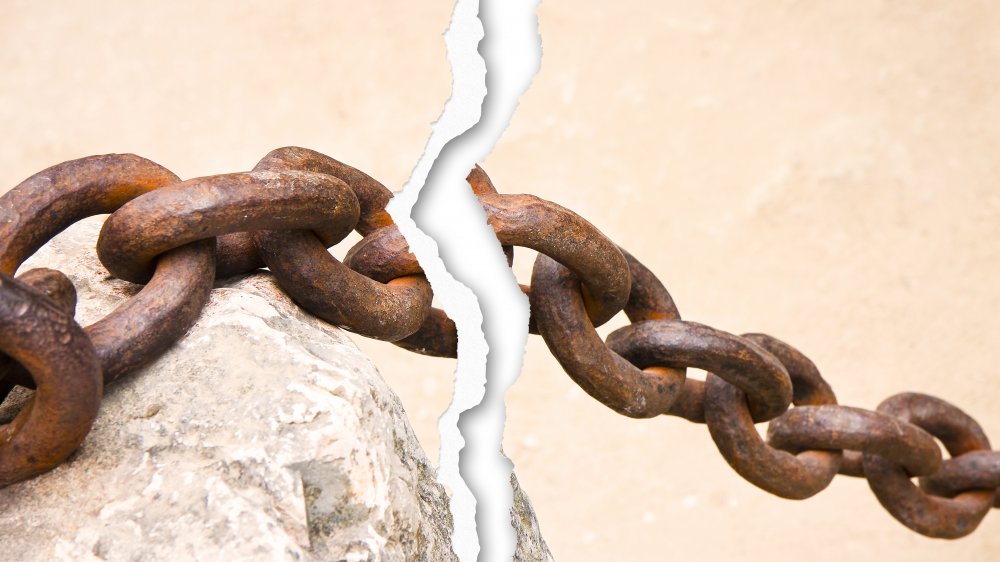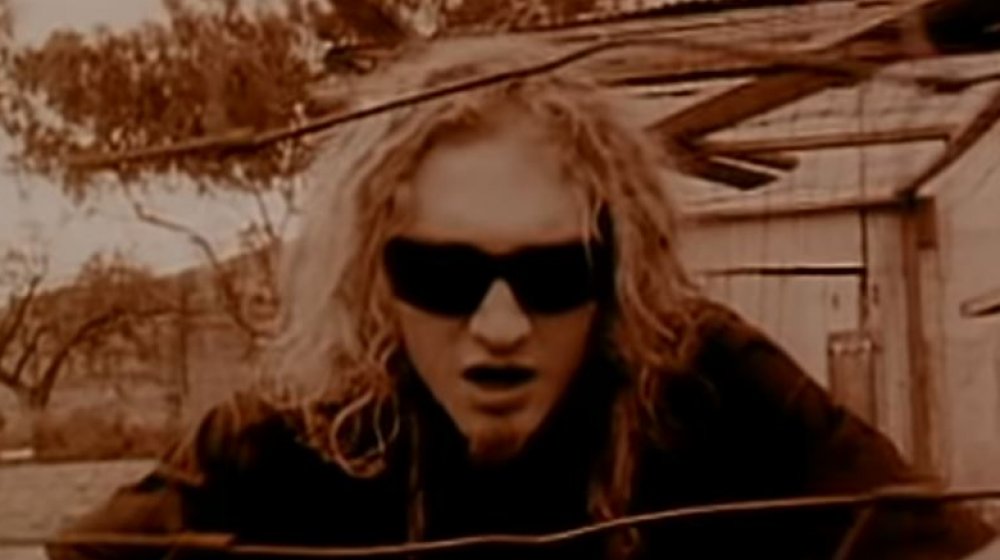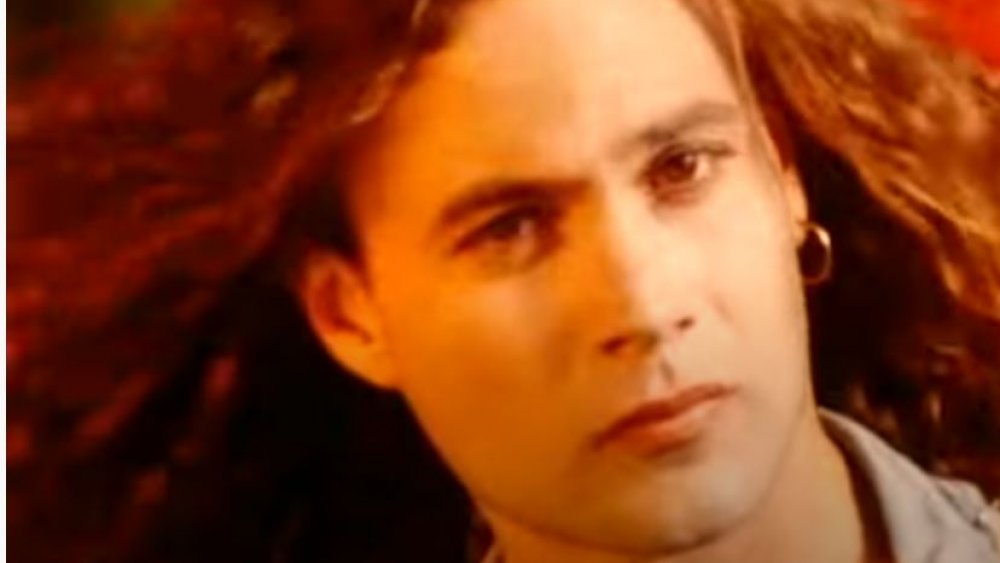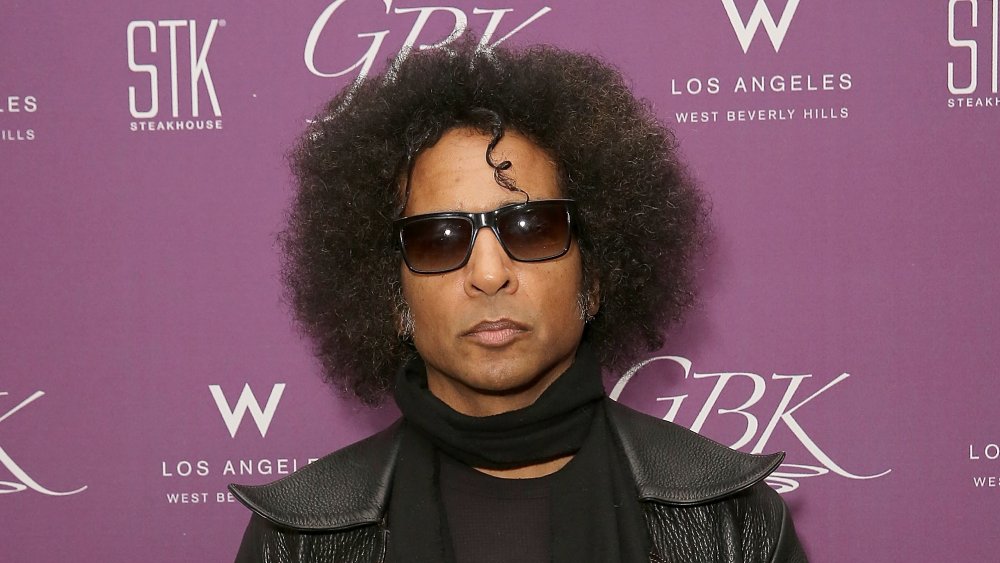The Tragic Real-Life Story Of Alice In Chains
Nirvana might have been the biggest name in grunge, Pearl Jam the most enduring, and Soundgarden the most hard-hitting, but as Stephen Hill of Louder tells us, it was Alice in Chains that first brought the genre into the mainstream with their sublime 1990 debut album, Facelift. Armed with a brand new sound that incorporated elements from heavy metal to the famous grunge drop-D tuning, the twin vocals of guitarist Jerry Cantrell and the charismatic frontman, Layne Staley, and the album's most iconic single, "Man in The Box," the band were instrumental in grunge's breakthrough. With their follow-up album, Dirt, Alice in Chains proved that they were far from a one-trick pony, and singles like "Would?," "Rooster," and "Them Bones" propelled them to further success.
However, despite their considerable fame and fortune, the band has had more than their share of disasters, thanks to an array of drama, unfortunate incidents, and rock star excess. Today, we'll take a look at the tragic real-life story of Alice in Chains.
Jerry Cantrell lost his mother and grandmother
As the songwriter, guitarist, and co-vocalist, Jerry Cantrell is responsible for much that makes Alice in Chains great, and seeing as the band's musical vibe tends to skew toward despair, it's no surprise that Cantrell has his share of personal tragedies. As James Hickie of Kerrang! tells us, one of the biggest blows came when Cantrell was only 21, and he lost his mother and grandmother over a short period of time. "Those losses really tilted my horizon," Cantrell says. "My whole f****ng life was basically taken away from me within the period of a year, and I felt like I was on my own."
Cantrell notes in Mark Yarn's Everybody Loves Our Town: A History of Grunge that he was living with the two women at the time, and when he was still dealing with the gut punch that was his grandmother's death, his mother informed him that she had mere months to live. Cantrell's mother was only 43 when she died of pancreatic cancer. In Greg Prato's book, Grunge Is Dead: The Oral History of Seattle Rock Music, Cantrell says that the losses happened within a span of six months or so, leading him to a situation where he had no immediate family (apparently, at that point his dad didn't count). As a very minor silver lining, his mother's insurance policy left him enough money to buy some music gear and "exist for a while."
Jerry Cantrell's father issues
Alice In Chains' guitarist and co-vocalist Jerry Cantrell may not have lived quite as rough a life as the band's famously tragic frontman, Layne Staley, but that doesn't mean he hasn't got his own share of past awfulness. As Louder reports, the aspiring rock star's difficult relationship with his father was such a case. Cantrell lost both his mother and grandmother at a relatively early age, and his relationship with his father was extremely strained, due to the fact that Cantrell Sr. had his share of psychological issues from his time in the Vietnam War. This, as Cantrell puts it in an interview with Rolling Stone, caused "a lot of problems and occurrences," which ultimately played a part in breaking up the family, leaving Cantrell and his father estranged.
Fortunately, the Cantrells eventually managed to grow closer after the guitarist was inspired to write a song about his father's experiences in Vietnam. He named the brooding, dark song "Rooster" after his dad's old nickname, and Cantrell Sr. was so fond of the end result that he agreed to appear in the music video.
Layne Staley's tragic loss
Alice in Chains frontman Layne Staley lived a life that was full of tragedy and doom, but as the A.V. Club tells us, the people close to the singer appear to think that a very specific point in time marked the start of his darkness. In October 1996, Staley was deeply shocked by the death of Demri Parrott, the vocalist's long-time girlfriend and fellow drug addict. The couple was already separated at that point, and while Staley had plenty of rock star money to finance his habits, Parrott's lower funds forced her to ultimately sell her body in order to finance her drug use.
Parrott's addiction resulted in fatal bacterial endocarditis, and Staley took the news of her passing extremely hard. In fact, those who knew him said that he "more or less died in spirit" when Parrott perished. Staley himself went on to explore dark paths that ultimately took his life, as well.
Layne Staley's hermit years
Layne Staley was a charismatic frontman with a golden voice, but according to the A.V. Club, the year 1996 marked a point when he turned his back to all of it. Like, literally all of it, except for drugs. Staley distanced himself from his band and the world in general, opting instead to taking copious amounts of narcotics and playing video games. Over time, this less than healthy lifestyle started taking a toll on the singer, who kept on keeping on down his dark path despite the numerous attempts his bandmates made to lure him back in the land of the living. Alice in Chains drummer Sean Kinney, in particular, attempted to contact Staley three times a week for years, but Staley refused to even talk to him.
Rumors about the vocalist's condition started making rounds, and some said he'd even lost an arm to gangrene. On the few occasions when Staley emerged from his self-imposed exile where drug dealers left illegal substances at his doorstep, he indeed resembled a shambling, grey zombie who'd even lost one or two fingers from collapsing veins, and generally looked "like an 80-year-old version of himself."
The difficult 'Dirt' album cycle
Alice in Chains' sophomore studio album, 1992's Dirt, was a massive success that cemented the band's place in the grunge pantheon and featured landmark hits like "Angry Chair," "Would?," and "Rooster." However, the making of the album was somehow an even darker process than the notoriously gloomy end result. As Rolling Stone writes, the Dirt sessions were seemingly cursed by misfortune, and were even interrupted by the 1992 Los Angeles riots, and the mayhem got so bad that assorted members of the band found it better to flee L.A. for Tijuana and Joshua Tree.
According to Revolver, things weren't much better when they were in the studio. The band was struggling with the newfound success their first album, Facelift, had brought them, and singer Layne Staley and bass player Mike Starr in particular were turning to drugs to the point it became a big issue. Staley was so out of it that he had to wear sunglasses when they shot the music video for "Rooster" so viewers wouldn't realize how high he was, while Starr's drug problems became so bad that the band had to ultimately fire him. Oh, and Staley even broke his foot shortly before they started touring the album as a warm-up act to Ozzy Osbourne, so he had to perform several dates in a wheelchair.
Alice in Chains breaks up
Alice In Chains might seem like a band that ended its existence in a tragic way when singer Layne Staley died, only to later rise from the ashes as a sort of 2.0 version of themselves with the advent of guitarist-singer William DuVall. According to Revolver, however, the band had started cracking at the seams well before Staley passed away, to the point that they even went their separate ways for quite a while.
The band had their last full tour with Staley in 1993, when they were co-headlining Lollapalooza. In 1994, they were set to tour with Metallica, but they ended up canceling just before the first dates. The reason? Staley's heroin addiction. Staley had recently gone to rehab, but soon afterwards, he showed up in a band rehearsal under influence. As Jon Wiederhorn of Rolling Stone writes, the rest of the band were less than pleased, to the point that drummer Sean Kinney swore he'd never play with Staley again. Guitarist Jerry Cantrell agreed with the sentiment, and just like that, Alice in Chains was on a break. They managed to patch things up six months later, but unfortunately, there was more awfulness on the horizon.
Sean Kinney's broken hand almost prevented him from playing on their debut album
Alice in Chains drummer Sean Kinney's tenure with the band has been comparatively tragedy free, though as Jon Wiederhorn of Rolling Stone tells us, Kinney did have his own struggles with alcohol abuse during the Layne Staley years. Still, as Loudwire reported in 2019, there was a time when the drummer's very presence on the band's first studio album, Facelift, was at risk.
As bad luck would have it, Kinney broke his hand before the band was due in the studio, and Greg Gilmore, the drummer of Mother Love Bone, sat in to take care of that side of things. Fortunately for Kinney, the producer, Dave Jerden, didn't feel that Gilmore could capture the Alice in Chains drum sound, so the band took a little while off ... but not enough for Kinney's hand to heal. Eventually, he decided that he couldn't miss the band's big break, so he cut off his cast and drummed on the album with a broken hand, cooling it with a bucket of ice he kept beside his drum kit. Truly, art is suffering.
Jerry Cantrell's repetitive motion injury
In an interview with the Los Angeles Times, Jerry Cantrell recalled that the road to their fifth studio album, 2013's The Devil Put Dinosaurs Here, was a painful one for him. The guitar maestro developed a repetitive motion injury and had to have surgery to fix the issue. According to Revolver Mag, the band had started working on the album soon after wrapping up their previous tour. However, after recording just one song, Cantrell started experiencing excruciating pain in his arm, which he described feeling "like an icepick in your joint." It turned out that the guitarist was suffering from a cartilage injury he had been sporting since 2005, as the years of intensive guitar heroics had worn down the glenoid labrum in his shoulder socket in a similar way that sometimes happens to baseball pitchers, leaving the bones to essentially grind on each other with painful results.
The injury and the ensuing surgical procedure set the musician (and the entire band) back several months. Still, Cantrell ultimately came to see a silver lining in the painful situation, as it forced him and the rest of the band to recharge their batteries before jumping right into a labor-intensive album cycle.
Layne Staley's tragic death
If the tragedies Alice in Chains has faced over the years were a mountain range, Layne Staley's death in 2002 would quite likely be its highest peak. As Dave Lifton of Ultimate Classic Rock reports, the 34-year-old singer was found dead in his apartment in Seattle. Though his long-time issues with drug addiction were well known, Staley had also been a recluse for quite some time. As such, his body wasn't found until two weeks after his death, when people realized they hadn't heard about him in a while.
When the police broke down the door of Staley's home, they found the singer's apartment in a sorry state, and its 6'1 occupant dead and so withered, he only weighed 86 pounds. Staley's place was full of various drugs and paraphernalia, and he was still clutching a syringe filled with the next intended dose of heroin. The death was ruled accidental, and caused by a "speedball" (a combination of cocaine and heroin).
Mike Starr's long fall from grace
When someone mentions drugs and Alice in Chains in the same sentence, most people probably think about singer Layne Staley. However, as Rolling Stone notes, poor Staley was hardly the only member of the band to struggle with addiction. Mike Starr, the band's original bass player, also developed a taste for narcotics early on. Starr took care of bass duties on Alice in Chains' beloved debut studio album, Facelift, as well as their even more esteemed sophomore effort, Dirt. He was there when they toured with giants like Van Halen and Iggy Pop — but sadly, so was his drug addiction.
Alice in Chains and Starr parted ways in 1993. Layne Staley said that Starr left because he didn't want to keep up with the band's hectic touring and press schedule, while Starr later said that he was straight up fired because of his addiction issues. Regardless of what actually happened, this marked the start of a long downfall. A year or two after his Alice in Chains days ended, Starr got in trouble for stealing luggage at an airport, and spent 90 days in jail. Later, he became something of a mainstay in reality shows of the Celebrity Rehab and Sober House variety.
The death of Mike Starr
Mike Starr was a founding member and the original bass player of Alice in Chains, but according to Rolling Stone, his voracious appetite for drugs became his undoing. By the time the band's second album, the esteemed Dirt, came out, Starr's substance abuse issues were so severe that he and the band went their separate ways.
Starr's life proved to be a hard one, as he found it difficult to shake his addiction. On March 8, 2011, the 44-year-old musician passed away in Salt Lake City, just a month after he'd been arrested for "unauthorized prescription drugs." Deseret News reported that Starr had been mixing his anxiety medication and methadone, and the Hollywood Reporter later confirmed that the poor bassist's cause of death had been a prescription drug overdose.
Per Billboard, the last two surviving original Alice in Chains members, Sean Kinney and Jerry Cantrell, said in a statement that they were in mourning, requesting privacy for both themselves and Starr's family. Starr also received a huge outpouring of love from fellow drummers like Mike Portnoy, Matt Sorum, and Steven Adler, as well as others who have struggled with addiction, such as Mötley Crüe's Nikki Sixx.
The William DuVall situation
As John Benson of Reuters tells us, the surviving members of Alice in Chains (guitarist-singer Jerry Cantrell, bassist Mike Inez, and drummer Sean Kinney) reunited in 2006 without a particularly clear vision of the shape of things to come. However, they soon discovered William DuVall, who ended up joining the band as a vocalist and a guitarist. In 2009, the new lineup released the fourth AiC studio album, Black Gives Way to Blue, and they've kept busy ever since.
As you can probably imagine, this didn't sit too well with many people, who saw the death of Layne Staley as the end of Alice in Chains, as well. The band continuing with its new lineup prompted criticism from such fans, and as Loudwire tells us, in 2018 the band decided to fire a volley right back at their critics. Cantrell pointed out that DuVall wasn't replacing Staley any more than Inez had replaced former bassist Mike Starr. "We never looked at it as a part of somebody is replaceable, because Layne Staley is not replaceable, Mike Starr is not replaceable," Cantrell said. "Their period of time with us in the band, on those records is indelible and completely unique." The guitarist also noted that while the negativity toward DuVall was still ongoing in 2018, Alice in Chains is ultimately their band and they are free to "create new chapters" for it as they see fit.




